University of Malaya
Universiti Malaya (Malay) | |
 Coat of arms of UM | |
Former name | King Edward VII College of Medicine, University of Malaya in Singapore |
|---|---|
| Motto | Ilmu Puncha Kemajuan |
Motto in English | Knowledge is the Source of Progress |
| Type | Public research university |
| Established | 28 September 1905[1][2] |
| Endowment | $385 million (August 2017) |
| Chancellor | Sultan Nazrin Muizzuddin Shah ibni Almarhum Sultan Azlan Muhibbuddin Shah Al-Maghfullah |
| Vice-Chancellor | Prof. Dato’ Ir. Dr. Mohd Hamdi Abd Shukor |
| Pro-Chancellors | Toh Puan Dato' Seri Dr. Hajah Aishah Ong Tan Sri Dato’ Seri Diraja Ramli Ngah TalibTan Sri Dato' Seri Siti Norma Yaakob |
| Students | 22,425 (January 2020) |
| Undergraduates | 14,291 (January 2020) |
| Postgraduates | 8,134 (January 2020) |
| Location | Kuala Lumpur , Malaysia 3°07′15″N 101°39′23″E / 3.12083°N 101.65639°ECoordinates: 3°07′15″N 101°39′23″E / 3.12083°N 101.65639°E |
| Colours | Red, gold and blue |
| Affiliations | ACU, APRU, ASAIHL, AUN, FUIW,[3] APUCEN, UAiTED |
| Website | www |
 | |
The University of Malaya (UM) (Malay: Universiti Malaya) is a public research university located in Kuala Lumpur, Malaysia. It is the oldest and highest ranking Malaysian institution of higher education according to two international ranking agencies.[4][5] The university has graduated four prime ministers of Malaysia, and other political, business, and cultural figures of national prominence. The predecessor of the university, King Edward VII College of Medicine, was established on 28 September 1905 in Singapore, then a territory of the British Empire. In October 1949, the merger of the King Edward VII College of Medicine and Raffles College created the university. Rapid growth during its first decade caused the university to organize as two autonomous divisions on 15 January 1959, one located in Singapore and the other in Kuala Lumpur. In 1960, the government of Malaysia indicated that these two divisions should become autonomous and separate national universities. One branch was located in Singapore, later becoming the National University of Singapore after the independence of Singapore from Malaysia, and the other branch was located in Kuala Lumpur, retaining the name University of Malaya. Legislation was passed in 1961 and the University of Malaya was established on 1 January 1962.[1][6][7][2] In 2012, UM was granted autonomy by the Ministry of Higher Education.[8]
Today, UM has more than 2,500 faculty members[citation needed] and is divided into thirteen faculties, two academies, five institutes and six academic centres.
In the latest QS World University Rankings, UM is currently ranked 59th in the world, 9th in Asia, 3rd in Southeast Asia and the highest ranked learning institution in Malaysia.[9]
The Faculty of Languages and Linguistics, Japanese Language and Linguistic Course was awarded the Japanese Foreign Minister’s Commendation for their contributions to promotion of Japanese language education in Malaysia on 1 December 2020.[10][11]
History[]
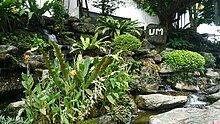
King Edward VII College of Medicine[]
The establishment of the university began with the issue of shortage of medical assistants in Singapore and Penang during the late 1890s.[12] The problem was addressed in a report published by the Education Commission in April 1902. In the report, it was stated that the Commission was in favour of establishing a medical school to fulfil the demand for medical assistants in government hospitals. However, such a view was not in favour among the European community.[13]
Legislation was passed by the Straits Legislative Council in June 1905 under Ordinance No. XV 1905. The school opened on 3 July 1905 and began functioning in September. On 28 September 1905, Sir John officiated the school under the name ‘The Straits and Federated Malay States Government Medical School.’[14]
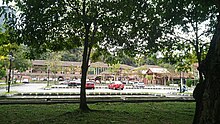
The school was located in the old Female Lunatic Asylum near the Singapore General Hospital at Sepoy Lines off New Bridge Road, where four of the asylum buildings were converted into a medical school. In 1907, a lecture hall and laboratory were added. There were no library and room to keep pathological specimens.[14]
In 1905, there were 17 medical students, four students attending the hospital assistant course. Five years later, the enrolments increased to 90 medical students and 30 trainee hospital assistants. The school had only one permanent staff which was the Principal, the teaching staff were employed on a part-time basis. The Principal was Dr Gerald Dudley Freer, who previously served as Senior Colonial Surgeon Resident of Penang.[15][16]
The School Council wanted to gain recognition of its Diploma by the General Council of Medical Education in the United Kingdom to ensure that the Licentiate of Medicine and Surgery Diploma offered by the school would gain worldwide recognition. In 1916, the GCME recognised the Licentiate of Medicine and Surgery Diploma offered by the school. The licentiates were placed on the General Council’s Colonial List of the British Medical Register and were entitled to practise anywhere within the British Empire.[17]
In 1910, Dr Robert Donald Keith became the second Principal of the School. The first two years of the five-year course were devoted to pure science studies. Physics, biology and chemistry were taught in the first year, followed by physiology and elementary anatomy in the second year. The remaining three years were attachment to clinical clerkships in medicine, surgery and midwifery, which covered pathology, hygiene and medical jurisprudence. Materia Medica was integrated into the fourth year, where practical pharmacy was taught.[18]
Students were posted to several hospitals, initially at the Singapore General Hospital. From 1908 onwards, attachments were made to Tan Tock Seng Hospital (for medicine and surgery) and Kandang Kerbau Maternity Hospital (for midwifery).[18]

In 1912, the medical school received an endowment of $120,000 from the King Edward VII Memorial Fund, started by Dr Lim Boon Keng. Subsequently, on 18 November 1913, the name of the school was changed to the King Edward VII School of Medicine.[19]
In the first batch of 16 students of 1905, only seven made to the final and graduated in May 1910 while the remaining six students graduated in four months later and others resigned from the school. In 1919, the drop-out rate had risen to 35%, while in 1939 the number of students failed in their final examinations stood at 44%.[17]
At this time a hostel was built to accommodate 72 male students from the Federated Malay States.
In 1921, the school was elevated in status to college. Between 1920 and 1930, the college went through a series of transformations, by replacing the old teaching staff with a younger generation of professionals and also nine new Chairs were created, the first in Anatomy in 1920, followed by Medicine, Surgery, and Midwifery & Gynaecology in 1922 and Clinical Surgery, Bacteriology, Biology, Bio-Chemistry, and Dental Surgery in 1926. And the tenth Chair for Pathology was created in 1935.[20]
In 1923, the college’s new building at Outram Road was commenced. It was completed in November 1925 and officially opened by Sir Laurence Guillemard in February 1926. During the opening ceremony, the College conferred Honorary Diplomas on Sir , Dr and Dr Lim Boon Keng.[21]
In 1929, Dr George V. Allen the new principal took the helm, succeeding his predecessor Dr MacAlister.
Raffles College[]
The establishment of Raffles College was a brainchild of Sir Stamford Raffles and Dr Robert Morison. Sir Stamford had some knowledge of the Malay language and culture, while Morison was a distinguished sinologist missionary. Both men wanted to establish a centre dedicating to the study of Malays and Chinese at tertiary level.[22]
On 5 June 1823, a site designated for an education institution had its foundation stone laid by Sir Stamford. Soon after that, Raffles left for England and Morrison left for China, thus the establishment of the school never happened. The school building was revived as an English school named the Raffles Institution.[22]
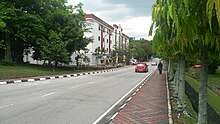
In 1918, Sir William George Maxwell, the Colonial Secretary of the Straits Settlements chaired the Maxwell Committee to review the scheme to commemorate the centenary of the founding of Singapore by Sir Stamford. The committee members were Roland Braddell, , , Dr Lim Boon Keng, , , and . The working committee headed by H.W. Firmstone recommended the establishment of a college for tertiary education to commemorate the centenary founding of Singapore.[23] On 12 July 1919, the Government decided to undertake the construction of the building with the cost not more than $1,000,000 and would contribute $50,000 as annual recurrent expenditure as soon as the Centenary Committee had collected $2,000,000 for the Raffles College Endowment Fund. On 31 August 1920, the Committee had achieved the figure, amounting to $2,391,040.[24] On 31 May 1920, Richard Olaf Winstedt was appointed as the Acting Principal of Raffles College. The course offered was a three-year basis. The establishment of the school was seen far more systematic compared to the King Edward VII Medical College. The school was situated at a site called the Economic Gardens and was designed by Cyril Farey and Graham Dawbarn. And the construction took place in 1926.[25]

On 22 July 1929, Raffles College was established to promote arts and social sciences at tertiary level for Malayans. The courses offered were divided into Art and Science streams. Four years later, the College Council proposed changes in the curriculum, so that the Diploma could be furthered to a Degree through external examinations in collaboration with universities in England.
In 1937, Sir Shenton Thomas declared the college would have a full-time Principal. The College had its fourth Principal, , succeeding . By 1939 war was waged in Europe, and had put a halt to the development of the college. The war in Europe came to Asia and Singapore was invaded by the Japanese in February 1942.
After the war, the school was reopened and W.E. Dyer was Principal. The future of Raffles College was uncertain, until 1948 when Dr George V. Allen (later Sir) who was formerly the Principal of King Edward VII Medical College posted as the last Principal of Raffles College. The college was amalgamated with the former, for the making of a university for the Malayans.
University of Malaya (1949–1967)[]

In 1938 the government appointed a commission under the chairmanship of Sir William H. McLean to study the higher education potential and progress in Malaya. The Commission concluded that Malaya was not ready to have a university, and that a university college would be more suitable. In 1939, the Higher Education in the British Colonies appointed a Commission led by Justice Asquith to further study the matter. The Commission shared the same opinion as the former McLean Commission.
In 1946, Dr Raymond Priestley, the Vice-Chancellor of Birmingham University was invited by the British Malaya Government to continue the review of setting up a University for Malaya. The Priestly Commission shared the same opinion as the McLean Commission, which was to form a university college first.
In 1947, the Secretary of State for the Colonies appointed Sir Alexander Carr-Saunders to chair a commission to study the development of tertiary education in Malaya. Initially, the Carr-Saunders Commission shared the same opinion as the McLean Commission. However, after the report was completed (but not yet summited to the Secretary of State), Sir Alexander listened to the thoughts of the Alumni Association of the King Edward VII College and also the Medical College Students Union. He was impressed with the ideas of the President of the Students Union, Dr K. Shamugaratnam. In 1948, the Carr-Saunders Commission supported the establishment of a university for the Malayans.
As a result, the institution named the University of Malaya was chartered under the Carr-Saunders Commission in 1949. The formation of the University of Malaya on 8 October 1949 in Singapore came from the merger of King Edward VII College of Medicine and Raffles College, which had been established in 1905 and 1929, respectively.
In Carr-Saunders Commission’s report in 1949, it was stated that "the university shall act as a single medium of mingle for enhancing the understanding among the multi-ethnics and religions in the back than Malaya. The University too should be modelled after the tertiary educations in the United Kingdom of Great Britain in term of academic system and administration structure".

The Carr-Saunders Commission postulates "the principle that all children who show the necessary capacity should enjoy an equal chance of reaching the University; and, in particular, that no able child should be handicapped in climbing the educational ladder by race, religion, rural domicile, or lack of means."
In 1959, the university was divided into two autonomous campuses, one in Singapore and the other in Kuala Lumpur. In 1961, the governments of Malaysia and Singapore passed the legislation to make the university a national university. As a result of such desire, on 1 January 1962 the University of Malaya in Kuala Lumpur was permanently located on a 309 hectare land and remained with the name. However, the campus in Singapore became the University of Singapore (today the National University of Singapore).
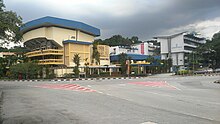
On 16 June 1962, the university celebrated the installation of its first Chancellor, Tunku Abdul Rahman, Malaysia's first Prime Minister. The first Vice-Chancellor was former Dean of Arts, Sir Alexander Oppenheim, the mathematician who formulated the Oppenheim conjecture in 1929.[26] When Oppenheim left in 1965 with no successor in sight, Rayson Huang who later went on to become the first Asian Vice-Chancellor of the University of Hong Kong,[27] was asked to take over as the Acting Vice-Chancellor. He served in that capacity for 12 months but declined reappointment to return to academic pursuits.[28]
Chin Fung Kee, an authority in geotechnical engineering,[29] replaced Huang as Acting Vice-Chancellor until the university filling the position in 1967 by the appointment of . A distinguished physicist and a fellow of Magdalen College, Oxford, Griffiths was also the former head of Clarendon Laboratory of Oxford University and one of the discoverers of ferromagnetic resonance.
Coat of arms[]
The University of Malaya’s Coat of Arms was designed under a Council established in 1961,chaired by Tan Sri Y.C. Foo. The members of the committee involved in the design were the Chairman of the Council, Y.C. Foo, Professor A. Oppenheim (the Vice-Chancellor) and Professor Ungku Aziz (later Regius Professor). The Coat of Arms was officially chartered in April 1962 by Tunku Abdul Rahman, the university’s first Chancellor.[30]
The Coat of Arms is divided into two parts, namely the Chief (upper part) and the Base (the remainder). The Chief is a bundle of seventeen strips of the leaves of Borassus flabellifer or the Palmrya palm. These strips were used as printed material for ancient books by the Malays, long before paper was invented. On the centre of these seventeen strips is the university’s motto ‘Ilmu Puncha Kemajuan’. The motto consists of ‘Ilmu’ derived from Arabic, ‘Puncha’ from Sanskrit, and ‘Kemajuan’ from Malay. These words mean knowledge is the source of progress.[30]
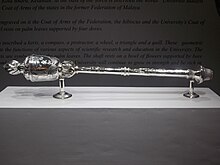
In the centre of the emblem is a Hibiscus rosa-sinensis species encircled by three Malayan tigers. The tigers symbolise the three main races in Malaysia (Malays, Chinese and Indians), who work hand-in-hand to protect the nation and uphold the duty to serve the country.[30]
Academic profile[]
| University rankings | |
|---|---|
| Global – Overall | |
| ARWU World[31] | 301–400 (2020) |
| QS World[32] | 59 (2021) |
| THE World[33] | 301–350 (2021) |
| USNWR Global[34] | 205 |
| Regional – Overall | |
| QS Asia[35] | 9 (2021) |
| THE Asia[36] | 43 (2020) |
| USNWR Asia[37] | 26 |
| National – Overall | |
| QS National[38] | 1 |
University of Malaya has been ranked consistently as the No. 1 university in Malaysia and among the top 3 universities in Southeast Asia, as well as among the top 400 universities in the world according to reputed ranking publisher such as QS, ARWU, US News & World Report in the recent few years.
In 2015 it has been ranked 54th in Engineering & Technology in QS world ranking. UM rose to the top 100 universities in the QS World University Rankings 2019, and has consistently increased in ranking to 59th in the world and 9th in Asia in the 2021 series.[39] In 2021, U.S. News & World Report ranked University of Malaya 17th and 87th in the world in Engineering and Computer Science respectively by its subject ranking.[40]
The business school of this university achieved two international accreditations i.e. Association to Advance Collegiate Schools of Business (AACSB) and Association of MBAs (AMBA).
| Year | Rank | Valuer |
|---|---|---|
| 2011 | 401–500 | Academic Ranking of World Universities |
| 2012 | 401–500 | Academic Ranking of World Universities |
| 2012 | 156 | QS World University Rankings |
| 2013 | 401-500 | Academic Ranking of World Universities |
| 2013 | 167 | QS World University Rankings |
| 2014 | 301-400 | Academic Ranking of World Universities |
| 2015 | 151 | QS World University Rankings |
| 2015 | 301-400 | Academic Ranking of World Universities |
| 2016 | 146 | QS World University Rankings |
| 2016 | 401-500 | Academic Ranking of World Universities |
| 2017 | 133 | QS World University Rankings |
| 2018 | 114 | QS World University Rankings |
| 2019 | 87 | QS World University Rankings |
| 2019 | 301–350 | Times Higher Education World University Rankings |
| 2020 | 70 | QS World University Rankings |
| 2020 | 301-350 | Times Higher Education World University Rankings |
| 2021 | 59 | QS World University Rankings |
| 2021 | 9 | QS World University Rankings-Asia |
| 2021 | 301-350 | Times Higher Education World University Rankings |
Transportation access[]

The University of Malaya campus is accessible by car, bus, and the LRT Kelana Jaya Line (Line 5) of the Klang Valley Integrated Transit System. Although walkable, the campus is large enough to make walking uncomfortable for some people due to the high daily temperatures and humidity in Kuala Lumpur, and individuals with disabilities may have difficulty due to limited crosswalks and a lack of sidewalks on some roads.
The campus can be accessed from the LRT Kelana Jaya line by alighting from KJ19 KL Gateway–Universiti LRT station, which is about a 15 minute walk from the campus' Kuala Lumpur entrance. Several bus routes enter and make stops on the campus.
Signage showing the direction of buildings and other sites appear frequently next to the campus roadways. These signs are designed for drivers, however, and on one-way roads, may not point out the most direct route to buildings for pedestrians.
Vice-chancellors[]
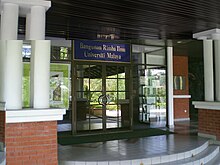
Faculties, Academies, Institutes & Centres[]
|
|
Partner institutions[]
|
|
Notable alumni[]
Throughout the years, University of Malaya has produced many notable alumni that have contributed significantly towards the development of Malaysia and abroad. This includes heads of states and heads of government, politicians, diplomats, entrepreneurs, lawyers, economists, academicians, athletes and media personalities.
- Notable University of Malaya Alumni
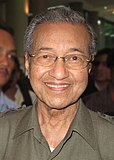
Mahathir Mohamad, 4th and 7th Prime Minister of Malaysia

Abdullah Ahmad Badawi, 5th Prime Minister of Malaysia

Muhyiddin Mohd Yassin,
8th Prime Minister of Malaysia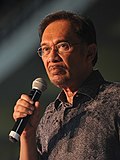
Anwar Ibrahim, 7th Deputy Prime Minister of Malaysia, Leader of the Opposition

Zeti Akhtar Aziz, 7th Governor of Central Bank of Malaysia

Wang Gungwu, 11th Vice-Chancellor of the University of Hong Kong, 3rd University Professor of National University of Singapore
Student bodies[]
The University of Malaya's campus student bodies, known as University of Malaya Students' Union (UMSU) are elected by the students to have representatives engaging in policies and matters relating to student affairs. As such the elections, known as 'PRKUM' which is acronym for Pilihanraya Kampus University Malaya in Malay language is seen as a precursor to a student leader.[43] Whilst prior elections before 2019 was organised by the Student Affairs Department of the University, the first election managed by the students[44] was conducted on 4 March 2019, marking a historic first whereby an all student affair made the elections a milestone. Suara Siswa, a pro-student group won the elections which saw 61% of 13,671 students cast their votes.[45]
Facilities[]
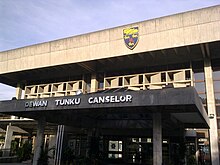

The university houses 12 residential colleges (11 in-campus, 1 off-campus), an Olympic-sized swimming pool, the Rimba Ilmu Botanical Gardens, the UM Arena which boasts a full course running track, several museums of different fields as well as numerous sports facilities (Gyms, courts and fields) in the campus. The university's teaching hospital, University of Malaya Medical Centre (UMMC) is located at the boundaries of UM near the Petaling Jaya gate.[citation needed]
Dewan Tunku Canselor (Tunku Chancellor Hall)[]The Dewan Tunku Canselor, also popularly known as DTC, is one of the 47 buildings listed under the National Heritage list, as well as a UNESCO Heritage Building. The building was named and officiated by the first prime minister of Malaysia, Tunku Abdul Rahman on 25 June 1996 where he became the university's chancellor at that time. It was designed by Dato' Kington Loo/CHR Bailey, an architect from the firm BEP Arkitek. Panggung Eksperimen (Experimental Theatre)[]University of Malaya Medical Centre (UMMC)[]Rimba Ilmu Botanical Gardens[]Residential Colleges[]
Museums and galleries[]
|
Libraries[]Central Library[]Branch libraries[]
Special libraries[]
|
See also[]
- University of Malaya Medical Centre
- University of Malaya Specialist Centre
- Faculty of Medicine, University of Malaya
- Centre for Foundation Studies (University of Malaya)
- University of Malaya Botanical Gardens Rimba Ilmu
- National University of Singapore
References[]
Citations[]
- ^ Jump up to: a b humans.txt. "Our History". www.um.edu.my. Retrieved 25 September 2017.
- ^ Jump up to: a b "University of Malaya – The oldest university in Malaysia". Malaysia Central. 6 June 2008. Retrieved 25 September 2017.
- ^ "Archived copy". Archived from the original on 26 January 2005. Retrieved 16 April 2010.CS1 maint: archived copy as title (link)
- ^ "World University Rankings". Times Higher Education (THE). 26 September 2018. Retrieved 11 May 2019.
- ^ "QS World University Rankings 2019". Top Universities. 29 May 2018. Retrieved 11 May 2019.
- ^ humans.txt. "UM Fact Sheet". www.um.edu.my. Retrieved 23 July 2018.
- ^ "Archived copy". Archived from the original on 20 June 2016. Retrieved 18 April 2017.CS1 maint: archived copy as title (link)
- ^ AMINUDDIN, MOHSIN. "UM set for autonomy". The Star. Archived from the original on 26 January 2012. Retrieved 10 February 2012.
- ^ "Universiti Malaya (UM)". QS Top Universities. Retrieved 31 July 2018.
- ^ Foreign Minister’s Commendations for FY 2020 | Ministry of Foreign Affairs of Japan
- ^ Foreign Minister’s Commendations for FY 2020 (Groups) | Ministry of Foreign Affairs of Japan
- ^ Khoo, Kay Kim (2005). "Early Medical Education". 100 Years: The University of Malaya. Kuala Lumpur, Malaysia: University of Malaya Press. pp. 1–2. ISBN 983-100-323-3.
- ^ Khoo, Kay Kim (2005). "The Foundation". 100 Years: The University of Malaya. Kuala Lumpur, Malaysia: University of Malaya Press. pp. 3–4. ISBN 983-100-323-3.
- ^ Jump up to: a b Khoo, Kay Kim (2005). "The Quest for Recognition". 100 Years: The University of Malaya. Kuala Lumpur, Malaysia: University of Malaya Press. p. 6. ISBN 983-100-323-3.
- ^ Khoo, Kay Kim (2005). "The Quest for Recognition". 100 Years: The University of Malaya. Kuala Lumpur, Malaysia: University of Malaya Press. pp. 6–9. ISBN 983-100-323-3.
- ^ Cheah, Jin Seng; TM Ho; BY Ng (July 2005). "The First Graduates in 1910". Annals Academy of Medicine (PDF). 6. 34. Singapore: National University of Singapore. pp. 19C.
- ^ Jump up to: a b Khoo, Kay Kim (2005). "Students: The Trail-Blazers". 100 Years: The University of Malaya. Kuala Lumpur, Malaysia: University of Malaya Press. p. 10. ISBN 983-100-323-3.
- ^ Jump up to: a b Khoo, Kay Kim (2005). "The Quest for Recognition". 100 Years: The University of Malaya. Kuala Lumpur, Malaysia: University of Malaya Press. p. 7. ISBN 983-100-323-3.
- ^ Khoo, Kay Kim (2005). "Students: The Trail-Blazers". 100 Years: The University of Malaya. Kuala Lumpur, Malaysia: University of Malaya Press. pp. 11–12. ISBN 983-100-323-3.
- ^ Khoo, Kay Kim (2005). "Consolidation". 100 Years: The University of Malaya. Kuala Lumpur, Malaysia: University of Malaya Press. pp. 12–14. ISBN 983-100-323-3.
- ^ Khoo, Kay Kim (2005). "Consolidation". 100 Years: The University of Malaya. Kuala Lumpur, Malaysia: University of Malaya Press. p. 14. ISBN 983-100-323-3.
- ^ Jump up to: a b Khoo, Kay Kim (2005). "Raffles College: Background". 100 Years: The University of Malaya. Kuala Lumpur, Malaysia: University of Malaya Press. p. 23. ISBN 983-100-323-3.
- ^ Khoo, Kay Kim (2005). "The Maxwell Committee". 100 Years: The University of Malaya. Kuala Lumpur, Malaysia: University of Malaya Press. p. 25. ISBN 983-100-323-3.
- ^ Khoo, Kay Kim (2005). "The Maxwell Committee". 100 Years: The University of Malaya. Kuala Lumpur, Malaysia: University of Malaya Press. p. 26. ISBN 983-100-323-3.
- ^ Khoo, Kay Kim (2005). "The Maxwell Committee". 100 Years: The University of Malaya. Kuala Lumpur, Malaysia: University of Malaya Press. p. 27. ISBN 983-100-323-3.
- ^ Greenfield, Richard (15 December 1997). "Obituary: Sir Alexander Oppenheim". The Independent. Retrieved 11 March 2021.
- ^ University of Hong Kong: A Liftime of Memories – Dr Rayson Huang Book Launch (retrieved 11 June 2008)
- ^ Huang, Rayson (2000). "A New University in a New Country". A Lifetime in Academia: An Autobiography by Rayson Huang. Hong Kong, China: Hong Kong University Press. pp. 81–83. ISBN 962-209-518-6.
- ^ Southeast Asian Geotechnical Society: A Brief History of the SEAGS Archived 20 April 2008 at the Wayback Machine
- ^ Jump up to: a b c Khoo, Kay Kim (2005). "Coat of Arms". 100 Years: The University of Malaya. Kuala Lumpur, Malaysia: University of Malaya Press. pp. ii. ISBN 983-100-323-3.
- ^ Academic Ranking of World Universities 2017
- ^ "QS World University Rankings 2021". Top Universities. 1 February 2017. Retrieved 25 November 2020.
- ^ "World University Rankings". Times Higher Education (THE). 26 September 2018. Retrieved 25 November 2020.
- ^ [1]
- ^ "QS University Rankings: Asia 2021". Top Universities. 1 February 2017. Retrieved 25 November 2020.
- ^ "Search". Times Higher Education (THE). Retrieved 25 November 2020.
- ^ [2]
- ^ "QS World University Rankings 2021".
- ^ "QS World Rankings University of Malaya".
- ^ "US News Ranking".
- ^ "Faculties, Academies, Institutes & Centres". University of Malaya.
- ^ "University Partners - Division of Community and International Networking". Universiti Tunku Abdul Rahman(UTAR). Retrieved 25 December 2019.
- ^ "A recap of the Universiti Malaya campus elections". Malaysiakini. 29 September 2016. Retrieved 5 March 2019.
- ^ Menon, Sandhya (22 February 2019). "Students to run UM campus polls". The Star. Retrieved 5 March 2019.
- ^ Chin, Christina (5 March 2019). "Pro Student Group wins majority of seats in UM Polls". The Star. Retrieved 5 March 2019.
Sources[]
External links[]
| Wikimedia Commons has media related to University of Malaya. |
- University of Malaya
- University of Malaya alumni
- Universities and colleges in Kuala Lumpur
- Public universities in Malaysia
- ASEAN University Network
- Educational institutions established in 1905
- Educational institutions established in 1949
- Law schools in Malaysia
- Business schools in Malaysia
- Engineering universities and colleges in Malaysia
- Information technology schools in Malaysia
- CCNA Networking Academy Program
- Medical schools in Malaysia
- Nursing schools in Malaysia
- 1905 establishments in British Malaya
- 1949 establishments in Malaya
- Winners of the Nikkei Asia Prize
- Educational institutions in Malaysia








